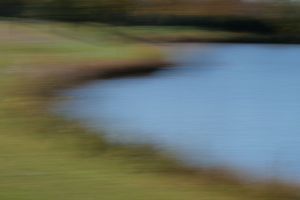Try a Photography Technique: Intentional Camera Movement (ICM)
What exactly is Intentional Camera Movement (ICM)? It is an abstract style – a creative way of working with long exposure photography, which involves deliberately moving the camera during an exposure to produce an artistic, painterly effect. It is definitely contrary to all the training a photographer receives to create sharp images by NOT moving the camera! However, according to Henri Cartier-Bresson, “Sharpness is a bourgeois concept.”
In ICM, during the exposure, image points move across the recording medium – a sensor or film – producing movement and direction in the image. Different kinds of effects can be created depending on the length of the shutter speed used and the movement of the camera during the exposure.

Field of Sunflowers: ISO 100, f/14, 1/80 sec, 100-300mm Zoom, upward movement
To achieve a properly exposed image while using a long shutter speed, specific settings and sometimes filters such as a Polarizing filter or a Neutral Density filter may need to be used. Usually, exposures of 1/2 to 1 second create the best results, which is to keep the shape of the subject but remove surface detail. First, set the camera on Manual or Shutter Priority.

Pond: ISO 100, f/16, 1/4 sec, 14-140mm Zoom, left to right movement
To make sure that the shutter speed is long enough to capture motion, but the image isn’t over-exposed, a low ISO – usually 100 – and a narrow f/stop should be used. There is no need to worry about issues with higher f/stops because of the camera movement. If the exposure is still too bright when using the low shutter speed, a circular polarizer or a Neutral Density filter can be screwed on the front of the lens to reduce the amount of light coming into the lens. If available light is reduced too much, then adjust the f/stop to let additional light in.

Hillwood Forest: ISO 100, f/10, 1/4 sec, 14-140mm Zoom, jiggle movement
Once the adjustments have been made to the camera settings so that a long shutter speed can be used, then experiment with camera movement. While shutter length is a key ingredient for ICM photography, it is the direction and speed of camera movement that has the biggest impact on the look, feel, and flow of an image. Try using a wide range of movements: panning up and down, side to side, moving the camera in a circular or arc motion, swooping, jiggling, rotating, and zooming. Try small movements and big movements, faster and slower shutter speeds. Unusual movements sometimes create the most painterly and eye-catching results. It will take some experimenting to create an image that you like.

Clouds at sunset: ISO 200, F/9, 1/2 sec, 14-140mm zoom, upward movement, slightly from left to right
Begin to move the camera as the shutter is pressed. Waiting until after the shutter is pressed reduces the amount of time for the camera to capture movement and also allows the camera to capture a slightly static image prior to capturing movement. Every image is subtly different and the slightest change in movement, shutter speed, or the speed of motion will yield very different results. Since digital cameras allow instant review of images, you can see if the settings and movement used has created the desired effect.

Ruby Sunflower (indoors): ISO 100, f/22, 1 sec, 14-140mm Zoom, lower left to upper right
Patience and experimentation are key! Having an open and curious mind is essential with ICM because it is all about seeing things differently, and “seeing” is the cornerstone to all creative photography. ICM isn’t for everyone, but it is worth trying. Who knows? It may just be something that spurs your creativity!
